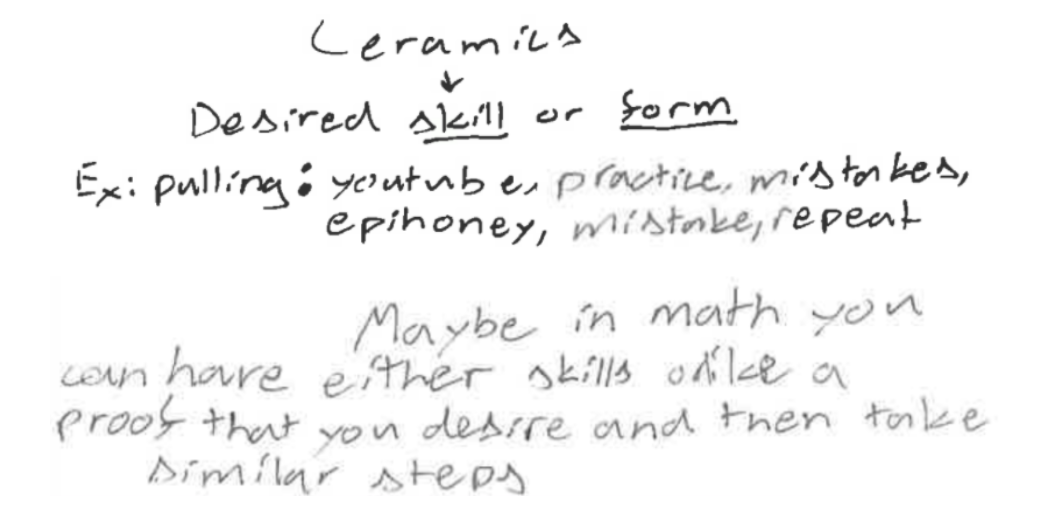|
by Annalee Salcedo Here’s a note my student, Hunter, wrote to me on the bottom of his quiz yesterday, in response to my question: “How can I make math class so it’s more like ceramics class?” Back story:
A few weeks ago, our ceramics teacher, John, announced he’d be offering an adult ceramics course on Saturday mornings to any interested faculty members. I signed up and so did several others, filling the class almost immediately. In our first class, John showed us around the ceramics studio, where to get the clay, how to wedge it, where various hand tools are and how they’re used. He demonstrated how to center, throw, pull and trim a bowl. Then he set us loose on the clay and told us to give it a try. I returned to the ceramics studio later that afternoon, and again the next day and the next day and the next day, every day trying to center, throw and pull a piece of clay into something, anything. When I messed up, I could throw the clay into the slip bucket, clean off my bat, and start over with another piece of clay. There were literally no stakes to making mistakes and this motivated me to just keep trying. A few days into my new obsession, I decided it would be interesting to observe my learning process. Here’s what I noticed about how I was learning:
Often, when I’m in the ceramics studio, there are students in there, too. They come not only when their ceramics class is scheduled, but also before sports, after dinner, when they’re done with homework for other classes, on Sunday afternoons. Today there was a student there who’s not actually in ceramics, but she was curious and interested and thought she’d give it a try. Other students who are in the ceramics course were coaching her. I’m finding that students are always eager to share their tips for centering, pulling, or trimming when I ask for their advice, and in the very beginning, some even offered unsolicited help because clearly I needed it. I shared these observations about my learning and about the culture of the ceramics studio with John and asked him the same question I had asked Hunter. How do I set up math class so it’s more like his truly student-driven ceramics class? John admitted that he didn’t have an answer, but acknowledged that teaching ceramics is way easier than teaching history, which he used to do. I see Hunter in the studio often, and he had asked about the adult class - when it happens, who’s in it, and he commented that he thought it was pretty cool to see teachers in the studio trying hard. So when he arrived to honors pre-calculus early today with clay smears on his pants and shirt, I asked him how I could set up math class so that it was more like ceramics. This started a flurry of ideas among the other students who had also arrived early. “You could just give us projects and let us figure stuff out”, said one student. “But how would we know if we were right?” asked another. “How do you know if what you made in ceramics was ‘right’?” I asked. “Well, there is no right or wrong in ceramics, just what you like,” someone else replied. “But in math, we have stuff we need to know,” said the student who needed to know if she was right. “Does ceramics have content standards?” I asked. “No.” “Actually, yes,” said Hunter. “Our bowls have to meet certain criteria. The shape inside should the same as the shape outside. The foot is one third the diameter.” As the bell rang to begin math class, I wondered if Hunter could state the criteria for success in our unit on trig as readily and clearly as he could for the unit on bowls in ceramics…Likely not, but more because of how I’ve set the unit up, and not because Hunter’s not paying attention. In fact, Hunter is actually quite a metacognitive thinker, as evidenced by his note that inspired this blog post in the first place. I collected the quizzes and it wasn't until I was on dorm duty tonight grading them that I saw that Hunter took some time after he'd finished and while others were still working to respond in writing to my question. It tells me he finds it as compelling a question as I do. What Hunter wrote resonates with me and I’m going to keep thinking about it: Start with “desired skill” then “youtube, practice, mistakes, epiphany [sic], mistakes, repeat.” This is exactly how I would describe my process as a learner in ceramics, and it has been an incredibly enriching experience so far. What can I do to set this process into motion for my students as they learn math? (Please comment if you have ideas!)
0 Comments
|
Authors
Taylor Wyatt Archives
May 2018
Categories |


 RSS Feed
RSS Feed
